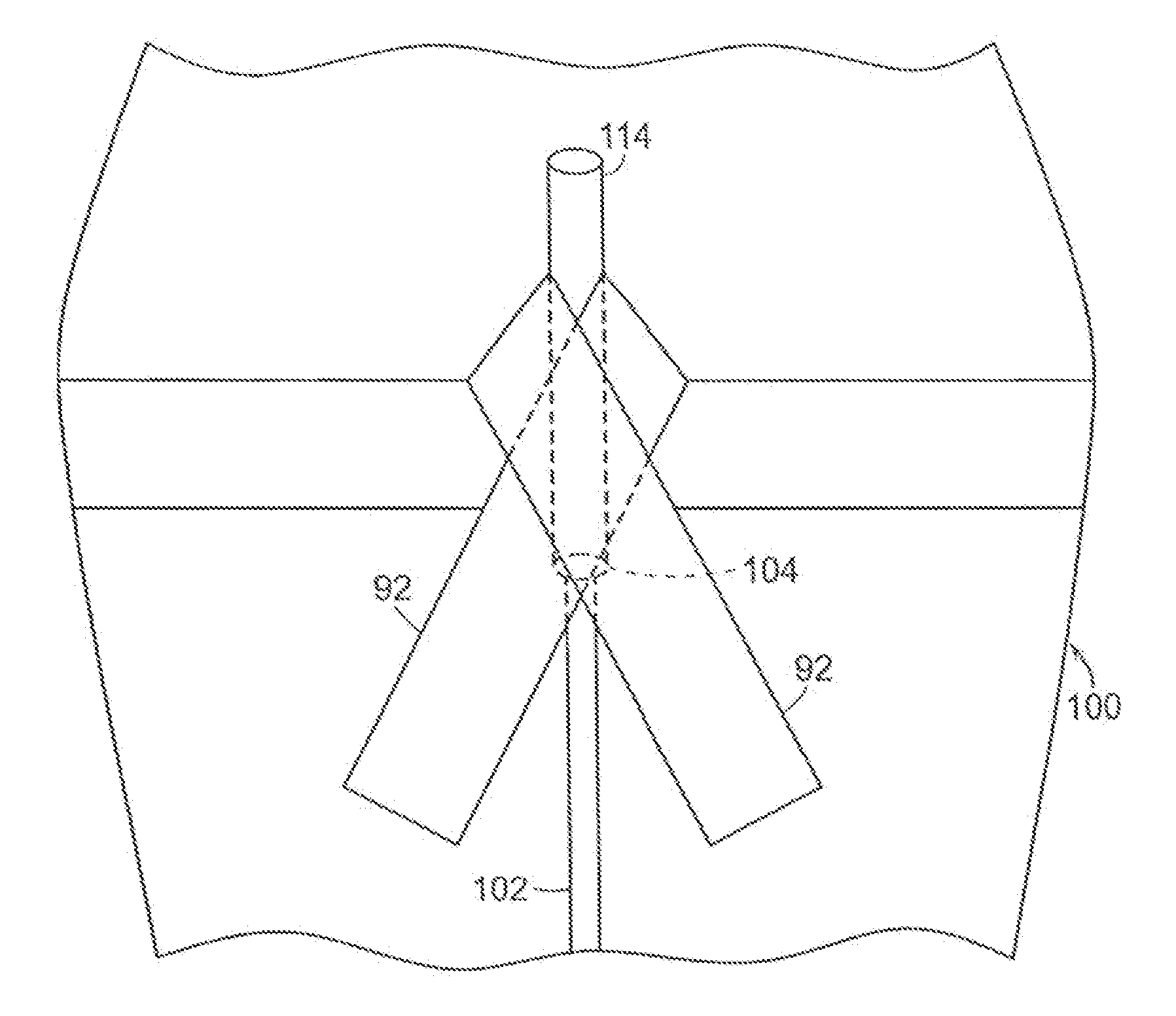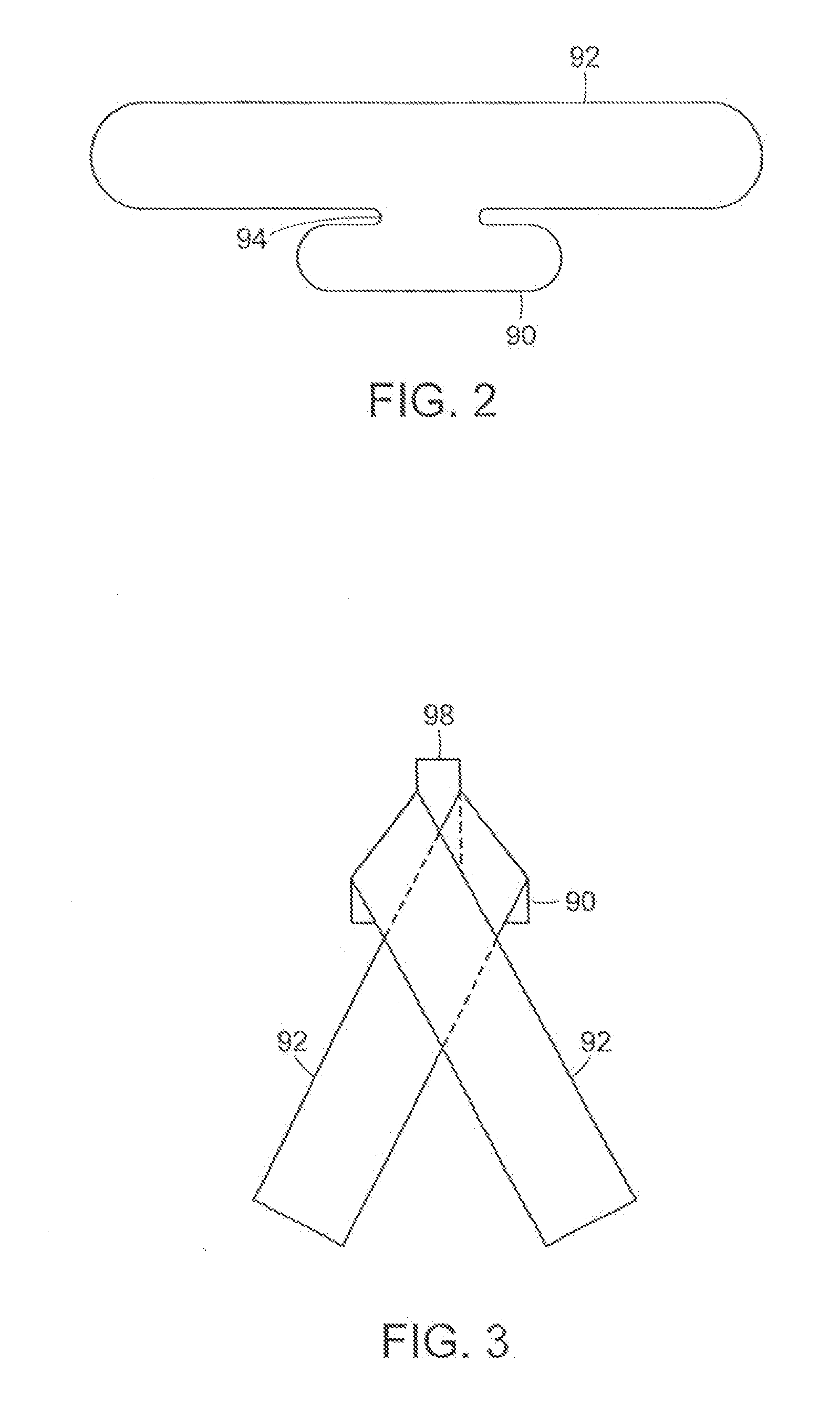[0010]A primary aspect of the present invention is to provide
adhesive layer arrangements for securing medical tubing to a body by positively gripping the tubing to avoid the above-described disadvantages of the prior art while facilitating application of the
adhesive layer arrangements.
[0011]Another aspect of the present invention is to utilize a hydrocolloid layer
delivery system to secure medical tubing to the body with a plow-fold release film facilitating adherence of a hydrocolloid layer to
skin by originally pulling part of the release film to secure the hydrocolloid layer to the
skin and thereafter using the plow-fold configuration to smoothly secure the hydrocolloid layer to the skin. Another release film can be supplied on the opposite side of the hydrocolloid layer such that when the other release layer is removed, medical tubing can be adhesively secured to the hydrocolloid layer. A second hydrocolloid layer can be disposed over the first hydrocolloid layer to hold the medical tubing therebetween, thus preventing lateral, longitudinal and rotational movement of the medical tubing as well as preventing the medical tubing from moving away from the body, i.e. peeling movement.
[0012]In a further aspect, an adhesive layer arrangement according to the subject invention provides circumferential gripping of a catheter thereby preventing kinking or collapse of the tubing lumen and
resultant loss of catheter patency.
[0013]In a another aspect, an adhesive layer arrangement according to the present invention includes a pair of oval-shaped hydrocolloid
layers utilizing a plow-fold release layer
delivery system to enhance application to skin and limit movement of medical tubing held therebetween, thus forming a hydrocolloid sandwich when upper and lower surfaces of the hydrocolloid
layers come together to comingle via cold-flow forming a full 360° seal of hydrocolloid around the medical tubing.
[0016]Some of the advantages of the present invention over prior art arrangements for securing medical tubing include securement of medical tubing in a simple manner, increased
infection control, cooperation with physical properties and
physiology of skin to reduce injuries, safety in use due to
elimination of structures which could cause tissue cuts, maceration or
necrosis, easier training of caregivers and use by caregivers, protection of lumen patency across a wide range of catheter dimensions, materials and clinical applications, reduction of the potential for infection due to the ability to create an occlusive seal against pathogens at
catheter insertion sites and / or prevention of catheter dislodgement.
[0017]Aspects and features of the present invention include an adhesive layer / laminate with a thickness of less than 30 millimeters thickness, any
adhesive materials or laminate than can simulate the same properties as skin in both
flexural modulus and elasticity modulus, an adhesive material capable of sealing to skin for more than 3 days, an adhesive material capable of managing
moisture transmission from skin without causing over hydration, maceration or wounding (capable of managing
moisture output of
normal skin and the skin of diaphoretic patients without causing skin breakdown), adhesive
layers sized to effectively secure catheters of sizes 1.7 french to 47 french, tabs of the
release liner contiguous with the adhesive layer and extending at least to the distal end of the adhesive layer, three separate release film components, an ovoid slot design for mounting the proximal portion of the slot in close approximation with a
catheter insertion site, either or both hydrocolloid layers having a window of transparent film (with a border of adhesive / hydrocolloid for adhesion) enhancing
insertion site observation, a
percutaneous seal may be a single layer used to perform all four necessary functions of adhering to skin, adhering to catheter, forming an occlusive seal around the catheter and forming an occlusive seal over the
insertion site, a
percutaneous seal may be a bi /
multiple layer configuration to perform all four necessary functions of adhering to skin, adhering to catheter, forming an occlusive seal around the catheter, and forming an occlusive seal over the insertion site, a multiple plow-fold
release liner / film component
assembly can be used to deliver the bottom adhesive layer of the “
airplane” device to the desired
application site including the
skin surface application and an “X” application pattern to create an occlusive seal at the
catheter insertion site, a lower adhesive layer may have a top film which is coated with a
release agent allowing the removal of the top film and exposing the hydrocolloid to create an adhesive
bed for the catheter, a transcutaneous seal release layer extending at least to the periphery of the adhesive layer enabling optimal orientation and application of the seal, and / or a slotted adhesive base for establishing
skin contact around a
catheter insertion site with the base having at least three separate release film components.
 Login to View More
Login to View More  Login to View More
Login to View More 


